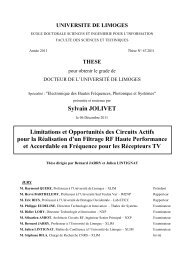Etude d'un procédé de gazéification de biomasse en ambiance ...
Etude d'un procédé de gazéification de biomasse en ambiance ...
Etude d'un procédé de gazéification de biomasse en ambiance ...
You also want an ePaper? Increase the reach of your titles
YUMPU automatically turns print PDFs into web optimized ePapers that Google loves.
Liste <strong>de</strong>s tableaux<br />
________________________________________________________________________________________________________________<br />
LISTE DES TABLEAUX<br />
Tableau I-1 : Composition moy<strong>en</strong>ne (% masse sèche) <strong>de</strong>s constituants principaux <strong>de</strong><br />
différ<strong>en</strong>tes <strong>biomasse</strong>s. ............................................................................................................. 15<br />
Tableau I-2 : Composition <strong>en</strong> c<strong>en</strong>dres <strong>de</strong> différ<strong>en</strong>tes <strong>biomasse</strong>s (ppm massique sur <strong>biomasse</strong><br />
anhydre) (Rave<strong>en</strong>dran, 1995).................................................................................................. 16<br />
Tableau I-3 : Propriétés thermochimiques moy<strong>en</strong>nes <strong>de</strong> différ<strong>en</strong>tes <strong>biomasse</strong>s et combustibles<br />
soli<strong>de</strong>s (Dupont, 2006). ........................................................................................................... 18<br />
Tableau I-4 : Production d’hydrogène à partir <strong>de</strong> <strong>biomasse</strong> par voies biologiques (Ballerini et<br />
Alazard-Toux, 2006). .............................................................................................................. 23<br />
Tableau I-5 : Comparaison <strong>de</strong>s PCI <strong>de</strong> matières premières et carburants actuels................... 24<br />
Tableau I-6 : Constantes cinétiques <strong>de</strong> la décomposition du bois........................................... 26<br />
Tableau I-7 : Evolution <strong>de</strong>s pourc<strong>en</strong>tages relatifs <strong>de</strong> soli<strong>de</strong>s (char), liqui<strong>de</strong>s (huile) et gaz <strong>en</strong><br />
fonction <strong>de</strong>s conditions <strong>de</strong> pression lors <strong>de</strong> la pyrolyse <strong>de</strong> la <strong>biomasse</strong> (Ballerini et Alazard-<br />
Toux, 2006). ............................................................................................................................ 30<br />
Tableau I-8 : Enthalpies <strong>de</strong>s réactions <strong>de</strong> <strong>gazéification</strong>. ......................................................... 34<br />
Tableau II-1 : Procédés <strong>de</strong> <strong>gazéification</strong>, les avantages et les inconvéni<strong>en</strong>ts (Dupont, 2006).44<br />
Tableau II-2 : Paramètres <strong>de</strong> marche <strong>de</strong> la torche hybri<strong>de</strong> à eau liqui<strong>de</strong> <strong>de</strong> l’Institut <strong>de</strong><br />
Physique <strong>de</strong>s Plasmas <strong>de</strong> Prague............................................................................................. 69<br />
Tableau II-3 : T<strong>en</strong>eur et composition <strong>de</strong>s goudrons obt<strong>en</strong>us par le <strong>procédé</strong> <strong>de</strong> <strong>gazéification</strong> <strong>de</strong><br />
l’Institut <strong>de</strong> Physique <strong>de</strong>s Plasmas <strong>de</strong> Prague. ........................................................................ 71<br />
Tableau III-1 : Propriétés moy<strong>en</strong>nes <strong>de</strong> différ<strong>en</strong>tes <strong>biomasse</strong>s et combustibles soli<strong>de</strong>s<br />
(Dupont, 2006). ....................................................................................................................... 79<br />
Tableau III-2 : Composition du bois <strong>de</strong> hêtre anhydre mesurée sur nos échantillons d’éclats<br />
« carrés » et son pouvoir calorifique. ...................................................................................... 80<br />
Tableau III-3 : Caractéristiques moy<strong>en</strong>nes <strong>de</strong>s particules, mesurées sur 100 échantillons..... 81<br />
Tableau III-4 : Composition chimique du verre n°2 (avant les essais <strong>de</strong> <strong>gazéification</strong>)......... 85<br />
Tableau III-5 : Caractéristiques <strong>de</strong>s briques <strong>de</strong> réfractaire...................................................... 86<br />
Tableau III-6 : Caractéristiques du creuset SiSiC. .................................................................. 89<br />
Tableau III-7 : Caractéristiques <strong>de</strong>s colonnes d’analyse du micro-GC................................. 100<br />
Tableau III-8 : Listes <strong>de</strong>s équations <strong>de</strong> thermiques disponibles dans Flux-Expert............... 110<br />
Tableau III-9 : Comparaison <strong>de</strong>s résultats <strong>de</strong> composition du système. ............................... 116<br />
Tableau III-10 : Energie nécessaire à la <strong>gazéification</strong> <strong>de</strong> 1 kg <strong>de</strong> <strong>biomasse</strong> humi<strong>de</strong> (20 %).120<br />
Tableau III-11 : Composition du gaz <strong>de</strong> synthèse <strong>en</strong> fonction <strong>de</strong> la pression....................... 121<br />
xvi
















